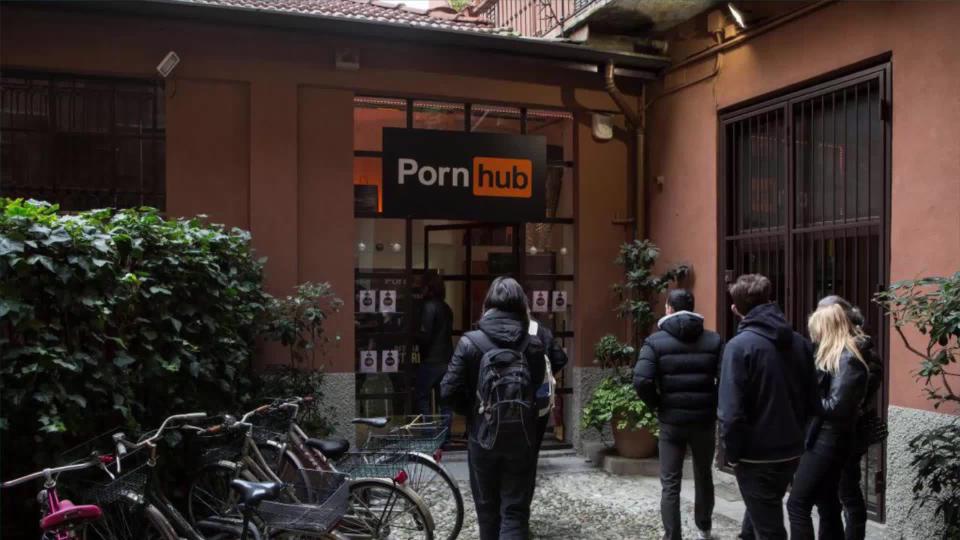The AI Renaissance portrait generator isn't great at painting people of color

Surprise! Artificial intelligence-generated portraits based off artwork from 15th century Europe... kind of suck at depicting people of color.
Because we're apparently always ready to hand over our photos for the sake of a trend, the internet's current obsession is an AI portrait generator that deconstructs your selfies and rebuilds them as Renaissance and Baroque portraits.
Created by researchers at the MIT-IBM Watson AI Lab, AI Portrait Ars is a fun way to see how you would have been perceived if you lived in another time period.
"Portraits interpret the external beauty, social status, and then go beyond our body and face," its creators wrote in the site's "Why" section. "A portrait becomes a psychological analysis and a deep reflection on our existence."
Unless, apparently, you're not white.
When I uploaded my photo into AI Portrait Ars, I was both horrified and amused by what the tool spat out. The painted version of me had my dark circles and eyebrows — at least my morning makeup routine is pulling through — but it whitened my skin to an unearthly pale tone, turned my flat nose into one with a prominent bridge and pointed end, and replaced my very hooded eyes with heavily lidded ones.
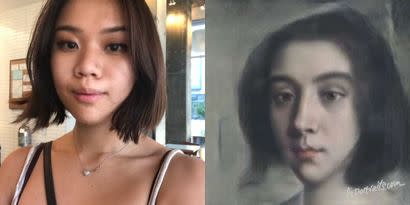
Image: MORGAN SUNG / AI PORTRAIT AR
We won't even talk about the atrocity that was supposed to be my lips.
The researchers wrote that the AI pulls from a data set of "tens of thousands of paintings from the Early Renaissance to Contemporary Art" using Generative Adversarial Network (GAN) models to produce "different styles and levels of abstraction."
There are two neural networks at play here: a discriminator, which figures out what makes a face and can recognize portraits, and a generator, which paints the portraits. Unlike neural style transfers, which take images and alter them with unique colors and textures while preserving the original's features, the AI Portrait Ars "paintings" completely redesign the original subject. In an example provided by the site, the creators say that the model settled on a "Renaissance style" and recreated its (white) subject by "highlighting the elegance of the aquiline nose, the smoothness of the forehead."
"This type of portraiture is quite distinctive of the Western artistic tradition," the creators continued on the site's "Why" section. "Training our models on a data set with such a strong bias leads us to reflect on the importance of AI fairness."
SEE ALSO: What you need to know about viral FaceApp's privacy policy
The creators at the MIT-IBM Watson AI Lab didn't respond to request for comment, and it's unclear how far the data set of artwork extends. Although the site says the data set includes contemporary art, it doesn't say whether it includes art featuring subjects of color.
The creators also emphasize the fact that the AI is focused on 15th century art, which could explain all the straight, high noses and much paler skin tones.
Even when the skin color change wasn't as drastic, the AI does appear to whitewash distinct features. Coin Center's Director of Communications Neeraj Agrawal said he was surprised at how his portrait turned out.
"The nose threw me off," he told Mashable in a Twitter DM. "The guy looked more Italian than Indian."
— Neeraj K. Agrawal (@NeerajKA) July 22, 2019
Polygon reporter Petrana Radulovic pointed out that the AI lightened her eyes and gave her nose a much higher bridge.
im sorry in what universe does my nose have a BRIDGE that could hold up my glasses pic.twitter.com/1TEatUGMyT
— Petrana 冰冰 Radulovic (@Pet_rana) July 22, 2019
And in a version that didn't lighten my skin tone, the AI still gave me a much narrower, sharper nose than my own.
As the AI Portrait AR creators note, the bias also extends to open-mouth smiles. Renaissance portrait artists rarely depicted their subjects with a toothy grin, because that feature was associated with a more comic painting genre — so the AI tends to swap out large smiles for the tight-lipped grimaces from its data set.
"The inability of artificial intelligence to reproduce our smiles is teaching us something about the history of art," the site's description says.
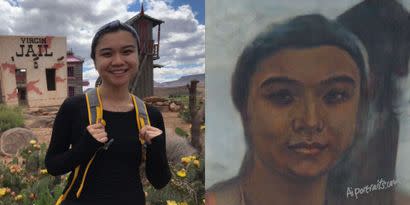
Image: MORGAN SUNG / AI PORTRAIT AR
That's not to say that there aren't any examples of non-white portrait subjects — the Tumblr account medievalpoc highlights plenty of people of color throughout European art history. While the artwork that can fit into the definition of "portrait" is limited, there are definitely examples of merchants, nobility, and clergymen who certainly weren't white.
Ka Bradley, a British Cambodian Twitter user, acknowledged that there could be cultural blindspots — Islamic laws forbade the depiction of sentient beings in artwork, for example. But even then, she challenges why European art is considered "classical" while art from other parts of the world during the same period isn't.
"I guess it's partly to do with Western Europe being the dominant cultural hegemony, with a history of colonizing other lands," she said in a Twitter DM to Mashable. "So Western portraiture is 'classical art' ... whereas figurative/portrait art from other spheres [around] the same time is [an] 'artifact' or 'ruin,' separated from its own developmental timeline and understood through the lens of the colonizer."
That being said, she wasn't particularly happy with her AI portrait, either.
viscerally distressed to announce that the ai portrait thing seems to think I’m a white woman, probably called Jocasta, who almost certainly has a job being someone’s niece pic.twitter.com/soSot4SYRO
— prahok is inside —} (@ka_bradley) July 22, 2019
Want some more examples? Here are some celebrities of color who had some, uh, especially strange results with the portrait generator.
SEE ALSO: Why absolutely everyone should be concerned about facial recognition
BTS's Jungkook was given more rounded brows, and his monolids were replaced with heavily lidded eyes.
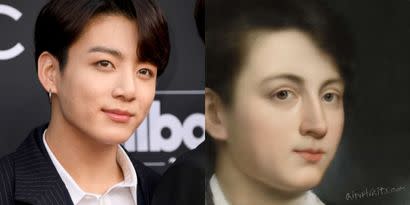
Image: GETTY IMAGES / AI PORTRAIT AR
While it kept her hair color, the AI narrowed Kehlani's nose and lightened her skin.
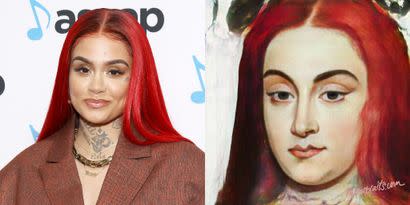
Image: GETTY IMAGES / AI PORTRAIT AR
The generator also lightened Tessa Thompson's skin color, and turned her braided hair into some kind of bulky hat.
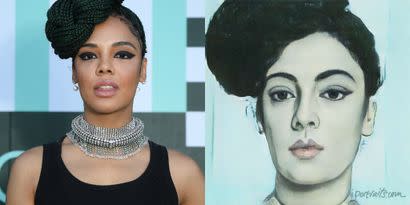
Image: GETTY IMAGES / AI PORTRAIT AR
Dwayne "The Rock" Johnson went from, well, "The Rock"... to a light pink thumb with green eyes.
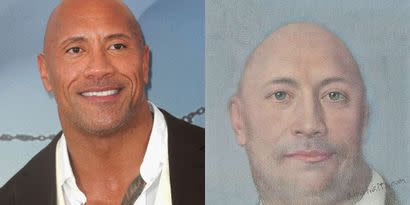
Image: GETTY IMAGES / AI PORTRAIT AR
There are no words to describe what it did to Lizzo.
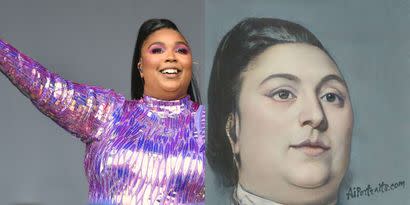
Image: GETTY IMAGES / AI PORTRAIT AR
For some celebrities, instead of altering skin tones, the AI resorted to depicting their darker shades as sketches. It still gave Idris Elba a prominent, European bridge and deeper-set eyes, though.
And it turned Jason Momoa into a hurried sketch of a grizzled ship captain, which may actually be pretty appropriate.
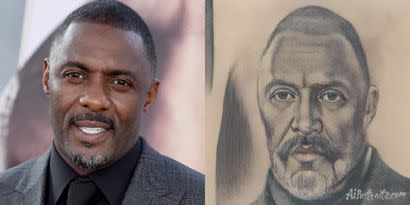
Image: GETTY IMAGES / AI PORTRAIT AR
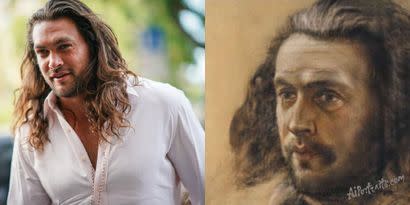
Image: GETTY IMAGES / AI PORTRAIT AR
As its creators acknowledge, the AI Portrait AR is an experiment in exploring the bias of the model. That being said, it raises eyebrows when the model is better at portraying a meme than an actual human being who doesn't happen to be white.
I FED AI PORTRAITS THE STONKS MEME AND I pic.twitter.com/IkGlzMIxoU
— Tony Hawk's Moving Castle (@0sorose) July 21, 2019
It's reminiscent of Google's Arts and Culture app, which promised to match users' selfies to documented works of art. Although it was well meaning, the app's database didn't include much artwork from non-European or American artists, and it struggled to match the faces of people of color.
The creators of AI Portrait Ars do nod to the vibrant portraiture of non-European cultures, but as they acknowledge, the software was trained on a data set consisting of mostly white features, and so it still can't identify and generate physical features that people of color have long been ostracized and othered for having.
Before social media helped normalize them, Western society has long looked down upon broad noses, darker skin tones, larger lips, and many other features. To overlook the depiction of people of color in Western art history, and omit them from the data set used to train a tool like this, isn't just a blind spot, but literal erasure.
While the AI Portrait AR is a fun example of how powerful technology has become, it's still disappointing for whole swaths of other cultures' physical features to be excluded from "art."
WATCH: Pornhub sees spike in searches for aliens, Area 51
